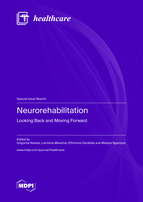Neurorehabilitation: Looking Back and Moving Forward
A special issue of Healthcare (ISSN 2227-9032).
Deadline for manuscript submissions: closed (31 March 2022) | Viewed by 35575
Special Issue Editors
Interests: cognitive and behavioral neurology; neurorehabilitation; multiple sclerosis; dementias; cognitive communication disorders
Special Issues, Collections and Topics in MDPI journals
2. Laboratory of Cognitive Neuroscience, School of Psychology, Aristotle University of Thessaloniki, Thessaloniki 541 24, Greece
Interests: clinical neuropsychology; cognitive/neuropsychological rehabilitation; cognitive neuroscience; multiple sclerosis; cognitive communication disorders
Special Issues, Collections and Topics in MDPI journals
2. School of Medicine, University of Thessaly, 41110 Larissa, Greece
Interests: neurosciences; neurology; neurogenetics; molecular neurology; cognitive impairment; neurorehabilitation
Special Issues, Collections and Topics in MDPI journals
Interests: rehabilitation medicine
Special Issues, Collections and Topics in MDPI journals
Special Issue Information
Dear Colleagues,
Neurorehabilitation is a complex, medically driven, set of therapeutic-targeted actions, applied to persons who live with neurological diseases, in order to restore or/and compensate for their disabilities. Progress in neurorehabilitation has been impressive over the years, but mainly in the last two decades. It follows the progress of clinical neurosciences in general, which is accelerated by a number of factors, technology being a major one. Looking back, we are satisfied by the transition of experienced-based, empirical neurorehabilitation, to an era of evidence-based practice, in which multidisciplinary approaches and translational research are applied even from the acute phase, through the disease course to an increasing number of people who need them, worldwide. However, despite this progress, there are still many limitations and restrictions. Nervous system damage frequently poses difficult recovery issues, and research still has a lot to clarify about the system’s neuroplasticity and reorganization dynamics. Additionally, more treatment approaches and combinations of therapeutic interventions need to be standardized, offered on a widespread basis, and individualized by a new generation of potent, skilled clinical neuroscientists, physicians, neuroradiologists neuropsychologists, and other therapists. Furthermore, these interventions must be organized under a fresh “patient-centric” approach, with home-based and tele-rehabilitation protocols replacing long stays in medical centers. In other words, we have to move forward to a new era, where medical, basic research, engineering and high technology advances can develop more efficacious approaches, which can be widely applied to all people that need them.
In this Special Issue of Healthcare, we welcome empirical, clinical, basic research and review papers covering the whole range of neurorehabilitation. Emphasis will be given, among others, to new technologies, cognitive rehabilitation, cognitive communication disorders (as a target of—but also as a hurdle for—rehabilitation), tele-rehabilitation approaches, the role of neuroimaging in designing and conducting relevant interventions, and neuromodulation techniques, mainly non-invasive (such as repetitive transcranial magnetic stimulation and transcranial direct current stimulation).
Dr. Grigorios Nasios
Prof. Dr. Lambros Messinis
Dr. Efthimios Dardiotis
Dr. Markos Sgantzos
Guest Editors
Manuscript Submission Information
Manuscripts should be submitted online at www.mdpi.com by registering and logging in to this website. Once you are registered, click here to go to the submission form. Manuscripts can be submitted until the deadline. All submissions that pass pre-check are peer-reviewed. Accepted papers will be published continuously in the journal (as soon as accepted) and will be listed together on the special issue website. Research articles, review articles as well as short communications are invited. For planned papers, a title and short abstract (about 100 words) can be sent to the Editorial Office for announcement on this website.
Submitted manuscripts should not have been published previously, nor be under consideration for publication elsewhere (except conference proceedings papers). All manuscripts are thoroughly refereed through a single-blind peer-review process. A guide for authors and other relevant information for submission of manuscripts is available on the Instructions for Authors page. Healthcare is an international peer-reviewed open access semimonthly journal published by MDPI.
Please visit the Instructions for Authors page before submitting a manuscript. The Article Processing Charge (APC) for publication in this open access journal is 2700 CHF (Swiss Francs). Submitted papers should be well formatted and use good English. Authors may use MDPI's English editing service prior to publication or during author revisions.
Keywords
- neurorehabilitation
- neuropsychological rehabilitation
- stroke
- multiple sclerosis
- neurocognitive disorders
- traumatic brain injury
- neuromodulation
- cognitive communication disorders
- tele-rehabilitation
- neuroimaging in neurorehabilitation









